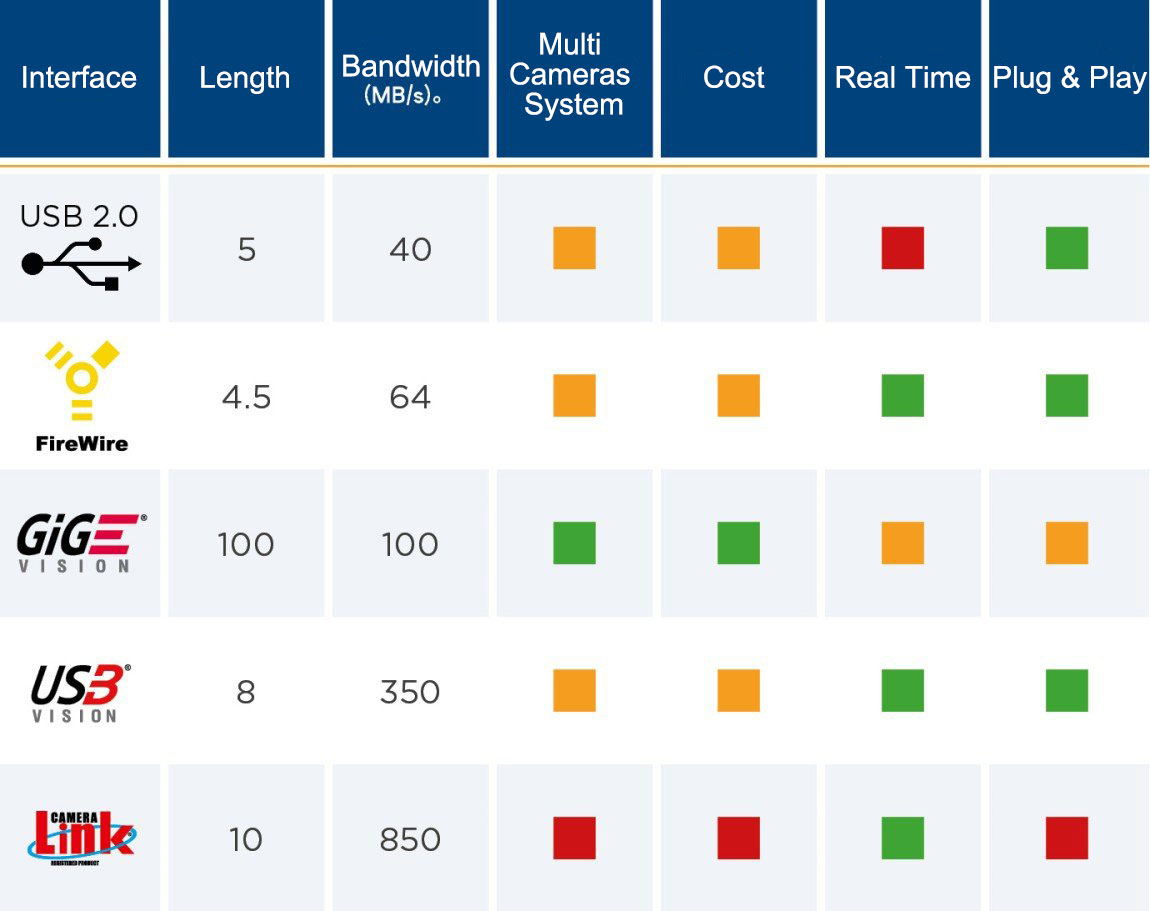USB 3.0 - Future-proof camera interface
USB 3.0 is the next generation (camera) interface, is the most commonly used interface in the mass market. The interface connect between two systems, such as a smartphone and a power outlet or between a camera and a PC.
To ensure that this consumer-facing interface is functional and stable when used in industrial installations, the Alliance of Camera Manufacturers has set an industry standard for the USB 3.0 interface. The result is the USB 3.0 Vision standard released in January 2013.
Use this standard to test various hardware and accessories for USB 3.0 Vision compliance. Any component certified with this certification works smoothly and consistently and meets the strict specifications of the industry.
USB 3.0 and its competitors
Of course, USB 3.0 is not the only camera interface on the market. Other common interfaces include Gigabit Ethernet (GigE), Camera Link, 1394 (FireWire) and USB 2.0. These interfaces have their own advantages and disadvantages, each for a different purpose. For example, GigE is suitable for long wires, and Camera Link is ideal when large bandwidth is required.
1394 (FireWire) and USB 2.0 are older technologies with obvious technical limitations; as the number of components that are compatible with this technology begins to decrease, it is recommended to use it with some reservations. 1394 (FireWire) delivers compelling plug-and-play and real-time compatibility features for its time, but now the cost-effective 1394 (FireWire) components are scarce and this trend is likely to persist. Replacing defective components is expected to become more expensive and difficult. In fact, in the medium term, 1394 (FireWire) may disappear from the market. USB 2.0 devices are inexpensive and commonly used, but the interface itself has been overtaken by the successor USB 3.0. More about this discussion later.
Depending on your application requirements, you can also choose between Camera Link, GigE or USB 3.0 to achieve the ideal combination of properties for fast, secure and reliable transfer of image data from your camera to your PC.
USB 3.0 combines the features of many different interfaces. The bandwidth it provides fills the gap between GigE and Camera Link speeds. Not only that, it is also compatible with plug-and-play features, low CPU load, but also has a reliable USB3 Vision industry standard. In addition, USB 3.0 also provides high reliability of data transfer between the host and device, and integrated (buffer) memory to meet the high stability requirements of industrial applications.

Comparison of different interfaces
USB and GigE
USB 3.0 is relatively new camera interface, relative to the wide application in the consumer market, its application in the machine vision market is still relatively limited. Experience has shown that in the industry, from the emergence of new interfaces to be accepted by the market, it usually takes about five years. There is a good example to prove this: the GigE Vision standard came out in 2006. GigE has spent years trying to earn enough subscribers worldwide to get the necessary scale. Today, GigE is one of the most important interfaces in the field of vision technology
USB 3.0 and USB 2.0
As mentioned above, we should also provide a comparison of USB 3.0 with its "pioneer" USB 2.0. One of the major bases for supporting USB 2.0 is the large number of available USB 2.0 components, but this is no longer applicable. The latest generation of computer hardware comes preloaded with a USB 3.0 interface. USB 3.0 components will be widely available in the coming years.
Another advantage of USB 3.0 is the greater bandwidth, which can increase camera speed. In addition, recent camera chips, such as the latest generation of CMOS chips, demand more power than the previous chips. This will prevent them from being used with USB 2.0 cameras. In contrast, USB 3.0 interface can provide enough power to run such chips. The interface also perfectly matches the resolution levels offered by a new generation of chips without slowing down the speed.
What will happen in the future?
USB 3.0 faces the problem every new interface faces: It makes sense to switch to new technology only if it truly delivers new value. The USB 3.0 is rapidly improving, the market share is increasing year by year. In the coming years, the USB 3.0 Vision standard is expected to capture the market more strongly. This will push USB 3.0 and GigE together to become the mainstream interface in the industrial machine vision market.